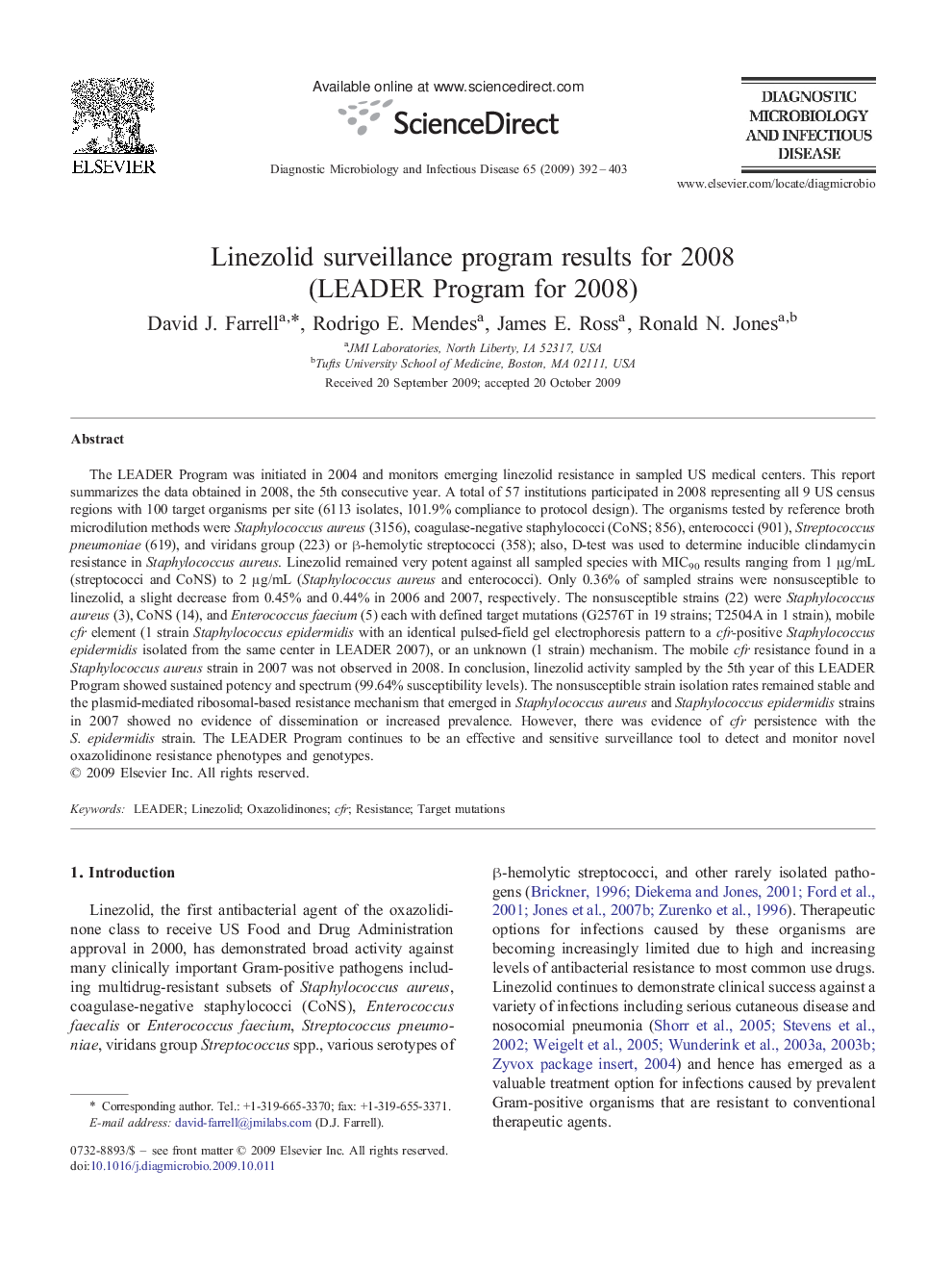| کد مقاله | کد نشریه | سال انتشار | مقاله انگلیسی | نسخه تمام متن |
|---|---|---|---|---|
| 3348214 | 1216003 | 2009 | 12 صفحه PDF | دانلود رایگان |
عنوان انگلیسی مقاله ISI
Linezolid surveillance program results for 2008 (LEADER Program for 2008)
دانلود مقاله + سفارش ترجمه
دانلود مقاله ISI انگلیسی
رایگان برای ایرانیان
موضوعات مرتبط
علوم زیستی و بیوفناوری
ایمنی شناسی و میکروب شناسی
میکروبیولوژی و بیوتکنولوژی کاربردی
پیش نمایش صفحه اول مقاله

چکیده انگلیسی
The LEADER Program was initiated in 2004 and monitors emerging linezolid resistance in sampled US medical centers. This report summarizes the data obtained in 2008, the 5th consecutive year. A total of 57 institutions participated in 2008 representing all 9 US census regions with 100 target organisms per site (6113 isolates, 101.9% compliance to protocol design). The organisms tested by reference broth microdilution methods were Staphylococcus aureus (3156), coagulase-negative staphylococci (CoNS; 856), enterococci (901), Streptococcus pneumoniae (619), and viridans group (223) or β-hemolytic streptococci (358); also, D-test was used to determine inducible clindamycin resistance in Staphylococcus aureus. Linezolid remained very potent against all sampled species with MIC90 results ranging from 1 μg/mL (streptococci and CoNS) to 2 μg/mL (Staphylococcus aureus and enterococci). Only 0.36% of sampled strains were nonsusceptible to linezolid, a slight decrease from 0.45% and 0.44% in 2006 and 2007, respectively. The nonsusceptible strains (22) were Staphylococcus aureus (3), CoNS (14), and Enterococcus faecium (5) each with defined target mutations (G2576T in 19 strains; T2504A in 1 strain), mobile cfr element (1 strain Staphylococcus epidermidis with an identical pulsed-field gel electrophoresis pattern to a cfr-positive Staphylococcus epidermidis isolated from the same center in LEADER 2007), or an unknown (1 strain) mechanism. The mobile cfr resistance found in a Staphylococcus aureus strain in 2007 was not observed in 2008. In conclusion, linezolid activity sampled by the 5th year of this LEADER Program showed sustained potency and spectrum (99.64% susceptibility levels). The nonsusceptible strain isolation rates remained stable and the plasmid-mediated ribosomal-based resistance mechanism that emerged in Staphylococcus aureus and Staphylococcus epidermidis strains in 2007 showed no evidence of dissemination or increased prevalence. However, there was evidence of cfr persistence with the S. epidermidis strain. The LEADER Program continues to be an effective and sensitive surveillance tool to detect and monitor novel oxazolidinone resistance phenotypes and genotypes.
ناشر
Database: Elsevier - ScienceDirect (ساینس دایرکت)
Journal: Diagnostic Microbiology and Infectious Disease - Volume 65, Issue 4, December 2009, Pages 392-403
Journal: Diagnostic Microbiology and Infectious Disease - Volume 65, Issue 4, December 2009, Pages 392-403
نویسندگان
David J. Farrell, Rodrigo E. Mendes, James E. Ross, Ronald N. Jones,